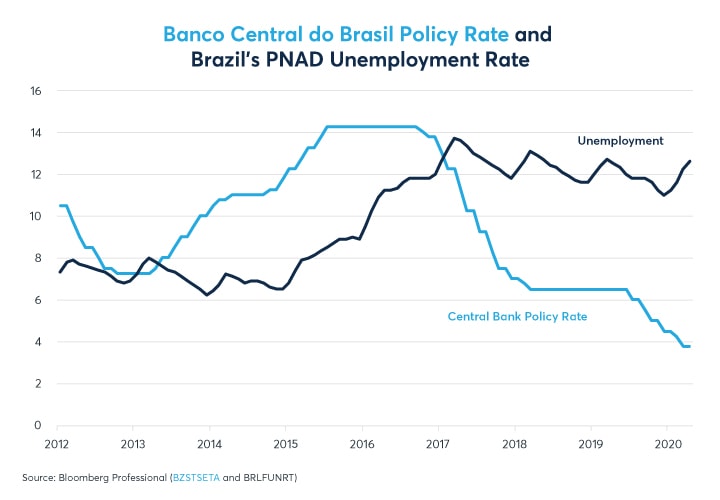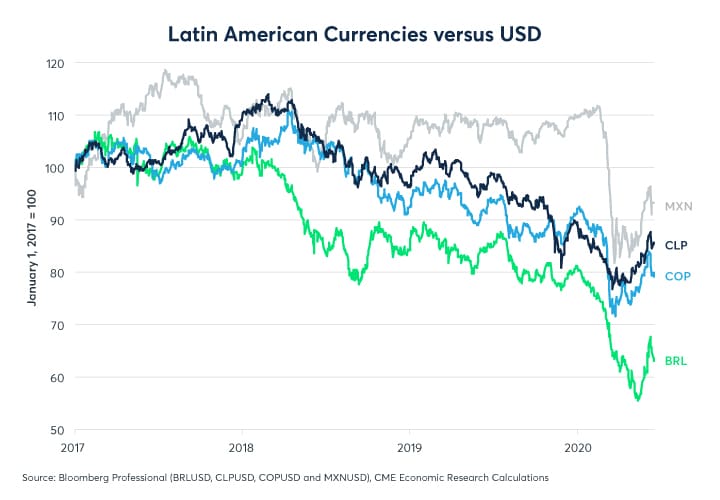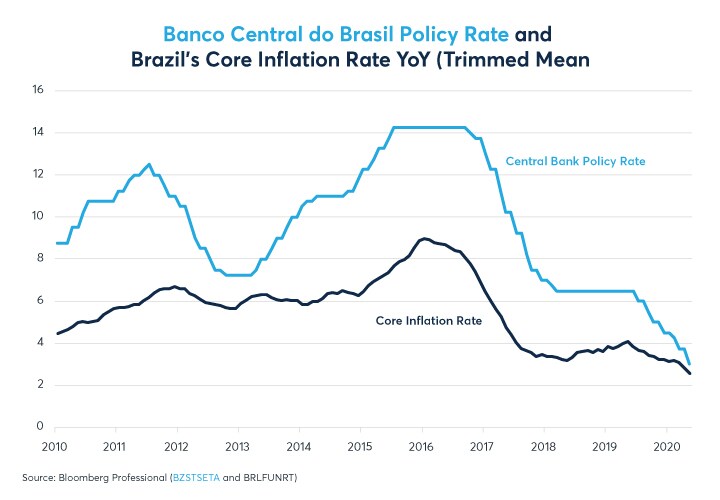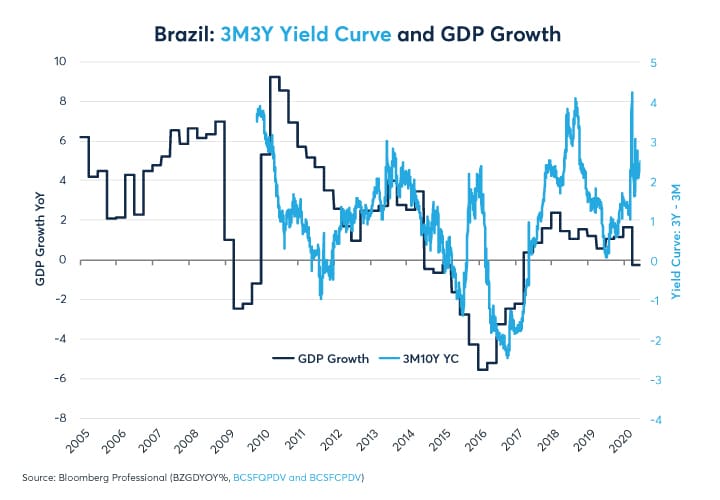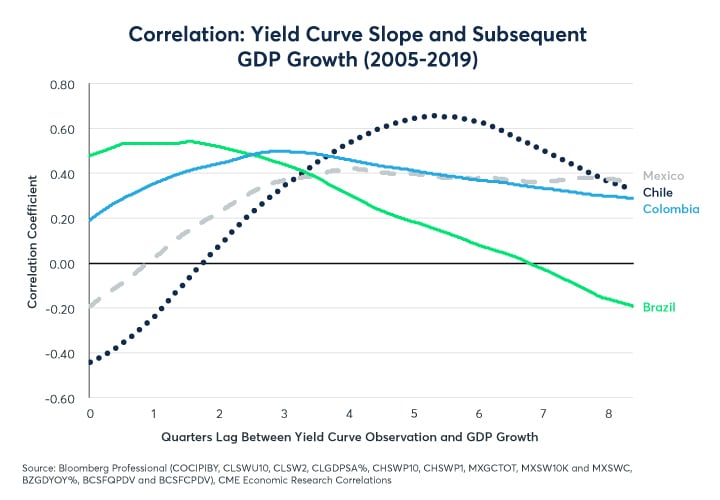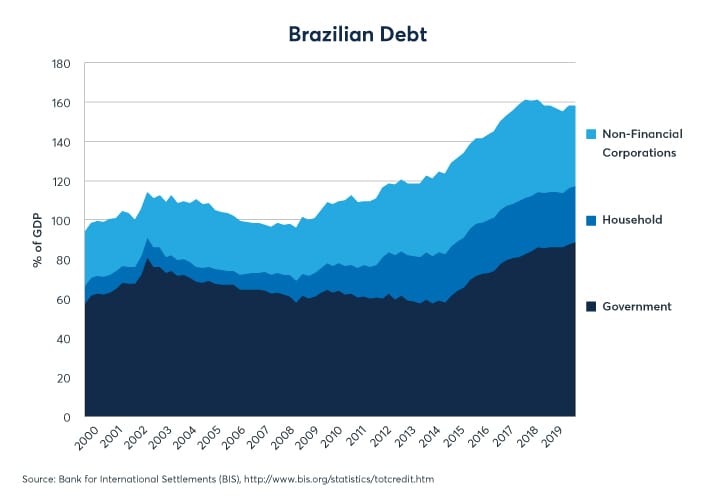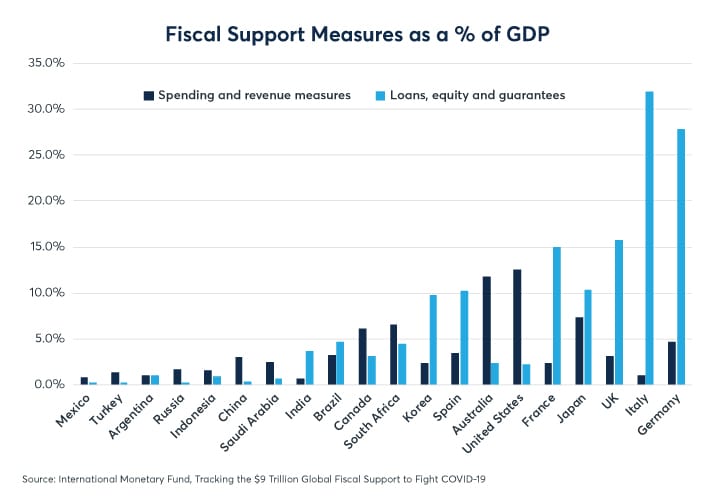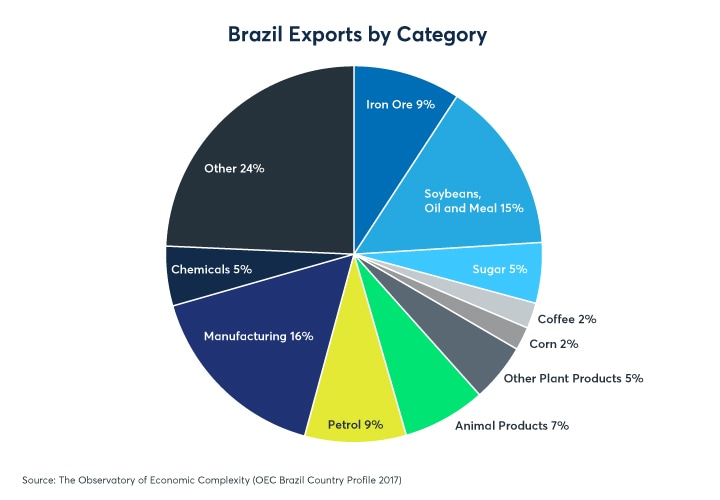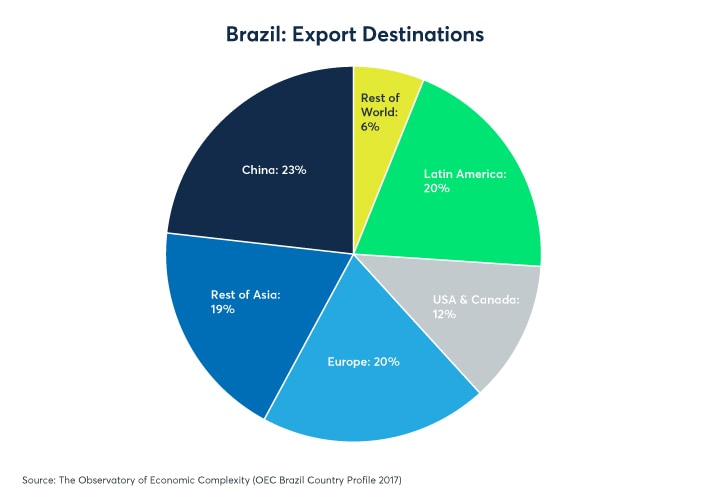After expanding rapidly for five years until mid-2014, the Brazilian economy hit a rough patch. From mid-2014 through mid-2017 it suffered through a recession that was followed by a tepid recovery. Unemployment rose from around 6% to nearly 14% (Figure 1).
Figure 1: From 2014-17 Brazil’s economy was in a recession, followed by a slow recovery
Now, hit hard by the COVID-19 pandemic, Brazil finds itself once again in a recession, with the International Monetary Fund forecasting a 5% contraction in real GDP for 2020. Amid these challenging circumstances, Brazil’s real (BRL) has underperformed its regional peers (Figure 2). Since mid-May, however, BRL has joined its peers in a strong rebound versus the US dollar. Indeed, there are a number of reasons to think that Brazil’s economic fortunes could soon turn for the better.
Figure 2: The Brazilian real (BRL) underperformed it Latin American peers
Despite Brazil’s hard times, there are several reasons to be optimistic about its economic future:
- Brazil’s central bank has sharply cut interest rates, and inflation appears contained for now
- Lower short-term rates have steepened the yield curve, a positive sign for future growth
- The government has achieved important pension reforms that should reduce deficits
Short-term interest rates
Part of the reason why Brazil suffered such a deep economic downturn in the 2014-17 period was that Banco Central do Brasil raised rates from 7.75% in early 2013 to as high as 14.75% in 2015 and 2016, reducing the flow of credit and pushing unemployment higher. As painful as that process was, higher interest rates achieved their primary aim: core inflation plunged nearly 9% in 2016 to between 3% and 4% in 2018-19 before falling below 3% earlier this year. Faced with economic weakness and low inflation, the central bank has taken its policy rate down to record lows (Figure 3).
Figure 3: Brazil’s real rates are now close to zero, a possible catalyst to economic growth
Real short-term interest rates (the central bank policy rate less core inflation) are close to zero. Exceptionally low short-term interest rates could help to stimulate a strong economic recovery once Brazil emerges from the pandemic, although numerous risks remain, including political ones.
The Yield Curve
As a result of low short-term rates, Brazil’s yield curve has steepened substantially and is now signaling a rebound on the horizon (Figure 4). Over the past 15 years, the shape of the yield curve correlated positively with the pace of growth during the subsequent six quarters (Figure 5).
Figure 4: Brazil’s positively sloped yield curve may herald solid post-pandemic growth
Figure 5: Brazil’s yield curve has correlated positively with the subsequent six quarters of growth since 2005
Fiscal reforms
Although Brazil has relied extensively on government borrowing to stimulate growth in the past, the current Administration has taken a different approach. It planned to achieve economic growth with its 2019 pension reforms and cuts to government expenditures. Moreover, it intends further fiscal reforms, privatization and other measures to “unlock” the economy, in the words of its Minister of the Economy, Paulo Guedes.
Lower interest rates might also ease the path towards fiscal reform. The average maturity of Brazil’s government debt is around four years, so it rolls into maturity relatively quickly. The fall in the central bank’s policy rate from 14.25% to 3% should shrink Brazil’s budget deficit substantially in the coming years. Brazil’s government debt has soared to 88.7% of GDP (Figure 6), nearly on par with countries like the United States and nations of the Eurozone, and it’s extremely high by the standards of emerging markets. A 1% decline in interest rates probably takes the equivalent of 0.2% off the country’s budget deficit per year. As such, so long as interest rates remain low, the country should find itself on a much more sustainable fiscal path. The trick, however, will be to keep inflation rates low as well so that Banco Central do Brasil does not feel the need to raise rates sharply once the economy begins to recover.
Figure 6: Brazil’s debt has soared, particularly for the public sector
High turnover in the Bolsonaro Administration and rising opposition to the government as the economy falters, however, may make it difficult to pass additional economic reforms. In recent weeks two Health Ministers, Luiz Henrique Mandetta and Nelson Teich, left the government as has Justice Minister, Sergio Moro, who led criminal investigations into the previous Administration known as Operation Car Wash, or Lava Jato locally.
Additionally, the pandemic will also increase the size of fiscal deficits in the short term. The government approved a law in April that provides for an emergency basic income of R$ 600 to informal workers and the self-employed. Among other measures, it also delayed payment of taxes for companies and created flexibility in implementing labor agreements on reduced workhours. Together, these measures are expected to add up to around 3% of GDP, far smaller than similar measures taken by the US and Europe but large by the standards of emerging countries (Figure 7). Additionally, Brazil has extended loan guarantees to companies impacted by the pandemic, which could contribute to future deficits if they are not paid back. So far, Brazil’s government has offered much more fiscal support than governments in China, India, Mexico or Russia. Even so, it may be difficult for Brazil to go any further down this path given the size of its government debt.
Figure 7: Brazil’s government is providing more fiscal support than in most other emerging markets
As for BRL, any sustained rise versus its peers will probably require:
- A move towards a larger current account surplus
- A rebound in economic growth
- Smaller budget deficits
The good news for Brazil is a large portion of its exports are agricultural goods (Figure 8). With China buying less of these goods from the US at the moment, Brazil’s food exports might remain in strong demand. Other exports, including airplanes, iron ore and oil, however, might have a more challenging time finding markets. And sadly, none of Brazil’s export markets are doing well economically (Figure 9). That said, the sharp contraction in Brazil’s domestic demand will probably shrink the amount of goods it imports and since imports are subtracted from GDP, that will boost GDP growth, at least on paper.
Figure 8: Brazil’s agricultural exports should buffer some of the coronavirus impact
Figure 9: Brazil’s export markets are in the throes of the pandemic
Bottom Line
- Record low interest rates could shrink deficits and boost growth.
- Low inflation is key to preventing interest rates from rising.
- Agricultural exports should buffer Brazil’s growth.
- Further fiscal reforms might be difficult to enact.
To learn more about futures and options, go to Benzinga's futures and options education resource.
Photo by sergio souza on Unsplash
© 2024 Benzinga.com. Benzinga does not provide investment advice. All rights reserved.
Comments
Trade confidently with insights and alerts from analyst ratings, free reports and breaking news that affects the stocks you care about.
